Gujarat Board GSEB Textbook Solutions Class 12 Biology Chapter 3 Human Reproduction Textbook Questions and Answers, Additional Important Questions, Notes Pdf.
Gujarat Board Textbook Solutions Class 12 Biology Chapter 3 Human Reproduction
GSEB Class 12 Biology Human Reproduction Text Book Questions and Answers
Question 1.
Fill in the blanks.
- Humans reproduce ……………… (asexually/sexually)
- Humans are ……………… (oviparous, viviparous, ovoviviparous)
- Fertilisation is ……………… in humans (external/internal)
- Male and female gametes are ……………… (diploid/haploid)
- Zygote is ……………… (diploid/haploid)
- The process of release of ovum from a mature follicle is called ………………
- Ovulation is induced by a hormone called ………………
- The fusion of male and female gametes is called ………………
- Fertilisation takes place in ………………
- Zygote divides to form ……………… which is implanted in the uterus.
- The structure which provides a vascular connection between foetus and uterus is called ………………
Answer:
- sexually
- viviparous
- internal
- haploid
- diploid
- ovulation
- LH
- fertilisation
- oviduct
- blastocyst
- placenta
![]()
Question 2.
Draw a labelled diagram of male reproductive system.
Answer:
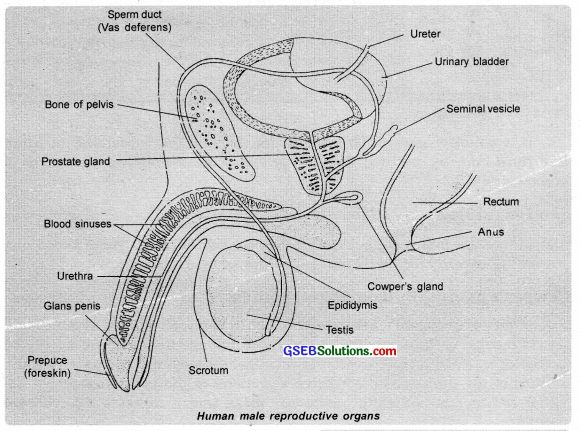
Question 3.
Draw a labelled diagram of female reproductive system.
Answer:
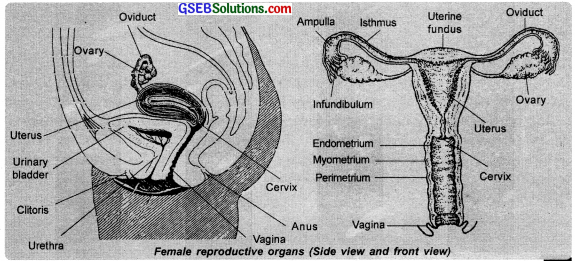
![]()
Question 4.
Write two major functions each of testis and ovary.
Answer:
Testis:
- Formation of sperms
- Secretion of the hormone testosterone.
Ovary:
- Formation of ova
- Secretion of hormone estrogen and progesterone.
Question 5.
Describe the structure of a seminiferous tubule.
Answer:
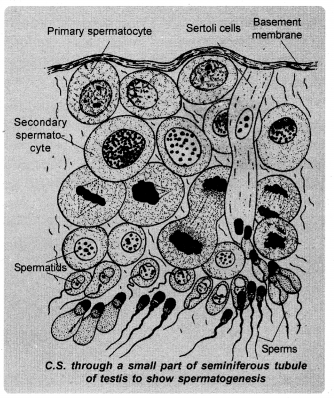
![]()
Question 6.
What is spermatogenesis? Briefly describe the process of spermatogenesis.
Answer:
The process of formation of sperm is known as spermatogenesis. The process of spermatogenesis includes the formation of spermatids and spermiogenesis.
Spermatogenesis is the process of the production of sperms from immature male germ cells. It starts at puberty and usually continues uninterrupted until death, although a slight decrease in the quantity of sperm is seen with the increase in age.
Process of Spermatogenesis:
The spermatogonia (2N) present at the inner side of the seminiferous tubules multiply by mitotic divisions and increase in number. They stop undergoing mitosis, grow and become primary spermatocytes (2N). Each primary spermatocyte undergoes meiosis to form two equal haploid secondary spermatocytes (N). Each secondary spermatocyte then undergoes a second meiotic division to form four equal haploid cells called spermatids (N). Spermatids receive nourishment to form sperms by the process called spermiogenesis.
Question 7.
Name the hormones involved in regulation of spermatogenesis.
Answer:
GnRH (from the hypothalamus), ICSH and FSH (pituitary), androsterone and testosterone (testis)
Question 8.
Define spermiogenesis and spermiation.
Answer:
- Spermiogenesis: Development and differentiation of spermatozoa (n) from a spermatid (n).
- Spermiation: The detachment of fully mature spermatozoa from Sertoli cells is called spermiation.
![]()
Question 9.
Draw a labelled diagram of sperm.
Answer:

Question 10.
What are the major components of seminal plasma?
Answer:
Fructose, fibrinogen, profibrinolysin, Calcium bicarbonate, prostaglandins, mucus, (seminal plasma + sperms = semen)
Question 11.
What are the major functions of male accessory ducts and glands?
Answer:
Accessory ducts such as vasa efferentia, epididymis and vas deferens provide a passage for the sperms. The secretion of prostate gland activates the swimming movement of the sperms. The secretion of seminal vesicle provides energy for the movement of the sperm. Moreover the secretions of accessary glands provide a fluid medium for transportation, nutrients and also provide an alkaline medium to counteract the acidity of the uterus.
![]()
Question 12.
What is oogenesis? Give a brief account of oogenesis.
Answer:
The process of formation and maturation of ovum is called oogenesis.
The process of formation and maturation of ovum is called Oogenesis. It takes place in the Graafian follicles. In a female foetus the ovaries may contain as many as 400,000 follicles. A woman normally ovulates 13 times a year for approximately 30 years. Hence a total number of about 400 eggs will mature and be released out through the reproductive period i.e., from puberty to menopause.
The process of oogenesis starts even before the birth of a mammal. In a new born human female all the germ cells are in a state of primary oocytes. Only after puberty the primary oocyte enters the stage of first meiosis. So oogenesis is a discontinuous process. Like spermatogenesis, oogenesis is also completed by three phases. They are
i. Multiplication phase
During this phase the primordial germ cells (germinal epithelial cells) undergo repeated mitotic division to produce egg mother cells or oogo- nia. These cells are diploid in nature.
ii. Growth phase
During this phase, some of the oogonia stop mitotic division and grow in size by accumulating nutritive materials in the form of yolk.
Now the cells are called primary oocytes. These cells are also diploid in nature. Since the egg contributes the greater part of the substances used in development, growth plays a major role in oogenesis than spermatogenesis. The developing primary oocyte is nourished by the follicle cells found around it. The follicle cells are the modified oogonia.
iii. Maturation phase
During this phase, the primary oocyte undergoes two divisions. As a result of first meiotic division (reduction division) two unequal haploid cells are formed. The larger cell is known as secondary oocyte and the smaller cell is known as polar body (or polocyte). The polar body is found attached to the animal pole of the secondary oocyte.
The secondary oocyte undergoes second meiotic division (second meiotic division takes place only after fertilization) and produces two unequal cells. The larger cell is known as functional ovum or ootid and the smaller cell is called second polar body. During this time the first polar body is divided into two. Thus during oogenesis a diploid oogonium gives one haploid ovum and three polar bodies. The latter eventually degenerate.
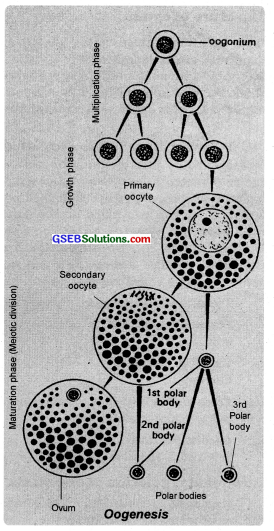
![]()
Question 13.
Draw a labelled diagram of a section through ovary.
Answer:
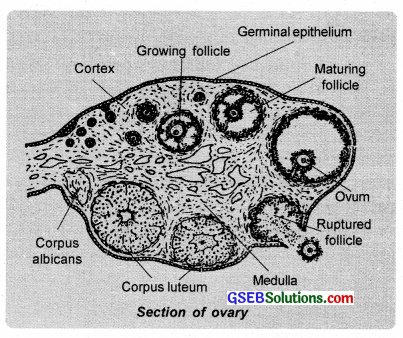
Question 14.
Draw a labelled diagram of a Graafian follicle.
Answer:
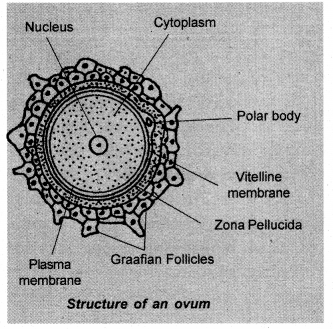
![]()
Question 15.
Name the functions of the following.
a. Corpus luteum
b. Endometrium
c. Acrosome
d. Sperm tail
e. Fimbriae
Answer:
a. Secretes progesterone.
b. Provides space for implantation.
c. Helps the sperm to enter into the egg.
d. Helps the sperm for movement.
e. Helps in collection of ovum after ovulation.
Question 16.
Identify True/False statements. Correct each false statement to make it true.
a. Androgens are produced by Sertoli cells. (True/False)
b. Spermatozoa get nutrition from Sertoli cells. (True/False)
c. Leydigells are found in ovary. (True/False)
d. Leydig cells synthesise androgens. (True/False)
e. Oogenesis takes place in corpus luteum. (True/False)
f. Menstrual cycle ceases during pregnancy. (True/False)
g. Presence or absence of hymen is not a reliable indicator of virginity or sexual experience. (True/False)
Answer:
(a) False: Spermatogenesis substances androgen binding protein and intubin are produced by Sertoli cells.
(b) False: Spermatozoa differentiate from spermatids with the help of spermatogenic factors produced by Sertoli cells.
(c) False: Leydig cells are found in testis.
(d) True.
(e) False: Oogenesis occurs inside the ovary.
(f) True.
(g) True.
![]()
Question 17.
What is the menstrual cycle? Which hormones regulate the menstrual cycle?
Answer:
The rhythmic series of changes in the sex organs that occur about every 28 days throughout reproductive life is called the menstrual cycle. FSH, Estrogens, LH and Progesterone regulate the menstrual cycle.
Question 18.
What is parturition? Which hormones are involved in the induction of parturition?
Answer:
Delivery of child is known as parturition or birth process. Oxytocin and relaxin helps in parturition.
Question 19.
In our society the women are often blamed for giving birth to daughters. Can you explain why this is not correct?
Answer:
Sex of the foetus is determined by father. Mother has no role in sex determination. So don’t blame mother for giving birth to daughters.
![]()
Question 20.
How many eggs are released by a human ovary in a month? How many eggs do you think would have been released if the mother gave birth to identical twins? Would your answer change if the twins born were fraternal?
Answer:
- Normally only one
- One egg
- If the twins were fraternal no doubt, mother would produce two eggs.
Question 21.
How many eggs do you think were released by the ovary of a female dog which gave birth to 6 puppies?
Answer:
Six eggs were released by the ovary of a female dog.
GSEB Class 12 Biology Human Reproduction Additional Important Questions and Answers
Question 1.
observe the picture shown below and answer the questions.
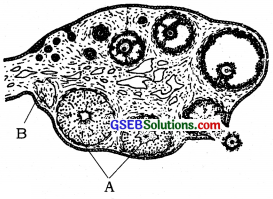
a. Identify A and B.
b. What is the future of these two parts with and without fertilization?
Answer:
a. A. Corpus luteum
B. Corpus albicans
b. If fertilisation is done, the corpus luteum would be present upto delivery. But if there is no fertilisation, the corpus luteum then forms corpus albicans and then it degenerates.
![]()
Question 2.
Find out the correct path of sperm and fertilized egg from the alternatives given below.
a. Vagina, uterus, cervix, oviduct
b. Vagina, cervix, oviduct, uterus
c. Cervix, oviduct, vagina, uterus
d. Uterus, cervix, vagina, oviduct
e. Uterus, oviduct, vagina, cervix
Answer:
Vagina, cervix, oviduct, uterus
Question 3.
Name the part analogous to penis seen in female reproductive system.
Answer:
Clitoris (highly sensitive organ)
![]()
Question 4.
It is interesting to note that in the female reproductive system there is no connection between the ovary and the remaining reproductive sys- tern.
a. How does an ovum enter the female reproductive system?
b. Name the parts seen in this portion.
Answer:
a. The matured ovum first falls into the abdominal cavity and from there it passes to the oviduct through a funnel shaped opening known as infundibulum.
b. Infundibulum, fimbriae and ampulla are the three regions seen in the oviduct.
Question 5.
Follicular atresia is seen in human reproductive system.
a. Identify the system.
b. Write a short note on this peculiar phenomenon.
Answer:
a. Female reproductive system
b. The total number of follicle cells seen in a normal young woman is about four lakhs. During the reproductive period, most of them undergo repression and disappear. The dead cells are replaced by phagocytosis. This is known as follicular atresia.
![]()
Question 6.
Give the differences between spermatogenesis and spermiogenesis.
Answer:
Spermatogenesis:
It is the process of the formation of mature spermatozoa in the testis. It involves meiotic and mitotic division. It is controlled by hormones like luteinizing hormone (LH) and androgen (testosterone).
Spermiogenesis:
It is the process of the transformation of spermatids into spermatozoa. It doesn’t involve any cell division. It is controlled by LH which stimulates the Sertoli cells to secrete the factors needed for spermiogenesis.
Question 7.
Arrange the given parts in two columns and give appropriate headings, tunica albuginea, antrum, rete testis, cumulus oophorus, corona radiata, epididymis, vasa efferentia, seminiferous tubules
Answer:
| Testis | Ovum |
| Rete testis | Tunica albuginea |
| Epididymis | Antrum |
| Vasa efferentia | Cumulus oophorus |
| Seminiferous tubules | Corona radiata |
Question 8.
Why does the coitus not leads to pregnancy all the time?
Answer:
Pregnancy occurs when the sperm and ovum reach the ampullary isthmus junction of the fallopian tube at the same time. During every coitus, both are not reaching this position together.
![]()
Question 9.
How is pregnancy calculated?
Answer:
Pregnancy takes usually 40 weeks (280 days) or about 9 calendar months if it is measured from the beginning of the last menstrual cycle.
Question 10.
Give the life span of
a. sperm
b. egg
Answer:
a. Sperm – 3 days or 72 hours.
b. Ovum – 1 day or 24 hours.
Question 11.
Diagrammatic representations of two ova are given below. Penetration of sperm is not possible in diagram A. to Write down the reason for this.
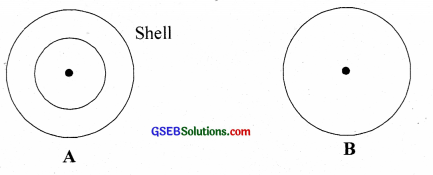
Answer:
Penetration of sperm is not possible in diagram A because the egg is cleidoic i.e., covered with a shell made of CaCO3.
![]()
Question 12.
Name the hormones secreted by human placenta.
Answer:
The hormones secreted by human placenta are;
- Human chorionic gonadotropin
- Progesterone
- Human placental lactogen
- Estrogen
Question 13.
The given statements specify the major events in gametogenesis. Compare and categorise the statements into two columns and give headings to the columns.
i. Transformation of nucleus into head.
ii. Meiotic division forms unequal haploid cells.
iii. Total 3 polar bodies are formed.
iv. Primary spermatocytes undergo meiotic division.
v. Germinal epithelial cells produce spermatozoa.
Answer:
|
Spermatogenesis |
Oogenesis |
| Germinal epithelial cells produce spermatozoa | Meiotic division forms unequal haploid cells |
| Primary spermatocytes undergo meiotic division | Total three polar bodies are formed |
| Transformation of nucleus into head |
Question 14.

The diagram above shows the hormonal control of spermatogenesis. Like this construct a diagram on hormonal control of oogenesis.
Answer:

![]()
Question 15.
Explain the terms. Vasectomy, Hysterectomy and Tubectomy.
Answer:
- Vasectomy: It is a method of male sterilization done by cutting and tying of vas deferens in males.
- Hysterectomy: It is an operation in which the uterus and the cervix are removed.
- Tubectomy: It is a method of female sterilization done by cutting and tying of fallopian tube.
Question 16.
The diagram below shows the formation of sperm. Like this draw a diagram showing the formation of ovum with suitable labels.

Answer:

![]()
Question 17.
Normally polyspermy does not occur.
a. What happens if it occurs?
b. Which structure prevents polyspermy in ovum?
Answer:
a. Development will not take place.
b. Fertilisation membrane
Question 18.
Mention the difference between breech birth and normal birth.
Answer:
In breech birth, the foetus presents buttocks first. In a normal birth, the foetus presents head first.
Question 19.
During embryonic development, some parts of the embryo differentiate into a set of membranes called the extraembryonic membrane.
a. Name the extraembryonic membrane.
b. Mention its importance in embryonic development.
Answer:
a. Amnion, chorion, allantois and yolk sac
b. All the membranes assist the process in embryonic development.
Question 20.
Generally the delivery room is described as labour room. Why?
Answer:
Generally the delivery room is described as labour room because the term labour (hard work) is used for the process in which muscular contractions force the foetus through the vagina.
![]()
Question 21.
In a breech birth, the baby is taken out by making an incision in the mother’s abdomen. The method is called ‘caesarean’ not ‘scissorian’. Why is it called so?
Answer:
It is believed that Julius Caesar said to have been born like this. Hence the name Caesarean operation
Question 22.
The following figure shows the safety periods and fertile period of a normal lady.

a. What is fertile period?
b. What is safety period?
c. What is the significance of 14th day in this figure?
Answer:
a. It is a period in which fertilization takes place.
b. It is a period in which fertilization will not take place.
c. It is the day of ovulation.
![]()
Question 23.
In mammals, the testes are placed in the scrotal sacs. Give reason.
Answer:
Scrotal sacs provide optimum temperature for spermatogenesis. In man the optimum temperature for spermatogenesis is 32-35°C. The body temperature of man is 37°C.
Question 24.
Siamese twins are always either male or female and never be male and female.
a. Why are the twins called Siamese twins?
b. What do you mean by identical twins?
c. What are fraternal twins?
Answer:
a. It was first reported in Siame. Hence the name.
b. The twins formed from a single zygote are called identical twins. Identical twins are always male or female.
c. The twins formed from different zygote are called fraternal twins. The fraternal twins are either male or female or male and female.
![]()
Question 25.
Placenta makes the intimacy between mother and foetus.
a. What is placenta?
b. In what way it makes intimacy with foetus?
c. Name the portions of foetal and maternal parts of placenta.
Answer:
a. Placenta is the physiological connection between the mother and the foetus.
b. The developing embryo gets nourishment and all other growth factors through the placenta. Similarly the wastes formed in the foetus are also eliminated through the placenta. All these make placenta more intimacy between mother and foetus.
c. Chorion is the foetal part and decidua basalis is the maternal part.
Question 26.
Copy the diagram. Identify and label any five parts.
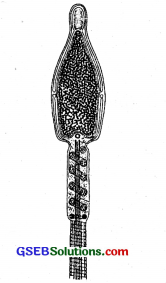
Answer:
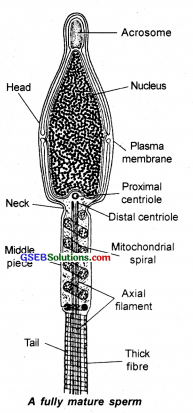
![]()
Question 27.
Name the accessory glands of human male reproductive system and mention their functions.
Answer:
The male accessory glands include
- a pair of seminal vesicle
- a prostrate gland
- a pair of the bulbourethral gland.
(1) a pair of seminal vesicle:
The secretion from these glands constitute the seminal plasma, which is rich in calcium fructose and certain enzymes.
(2) a prostate gland:
Seminal plasma provides the fluid medium for the-sperm to swim in the female reproduction tract, towards the ovum.
(3) a pair of bulbourethral gland:
It provides nourishment to the sperm. The secretions from bulbourethral glands help in the lubrication of the penis.
![]()
Question 28.
Find out the correct sequence from below.
a. Fertilisation → zygote → blastula → morula cleavage → gastrula
b. Cleavage → zygote fertilisation → morula → blastula → gastrula
c. Fertilisation → cleavage → morula → zygote → blastula → gastrula
d. Fertilisation → zygote → cleavage → morula → blastula → gastrula
e. Zygote → fertilisation → gastrula → cleavage → morula.
Answer:
d
Question 29.
The ovum is surrounded by four membranes. How can a sperm enter and fuse with the female pronuclei?
Answer:
Sperm produces antifertilizin, spermlysin etc. to break the membranes of the ovum.
Question 30.
Observe the diagrams and answer the questions that follow.
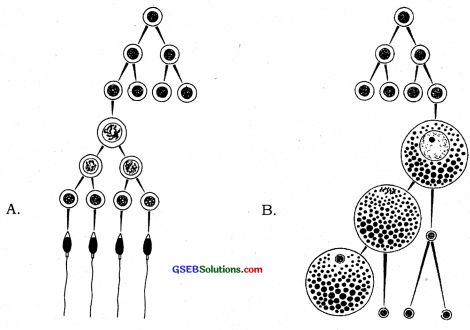
a. Give the names of these two processes A and B seen in human reproduction.
b. Name the three phases involved in these events.
c. If there are any differences in these processes A and B, give details.
Answer:
a. A – Spermatogenesis B – Oogenesis
b. Multiplication phase, growth phase and maturation phase.
c.
| Spermatogenesis |
Oogenesis |
| i. It occurs in the testis. | i. It occurs in the ovary. |
| ii. Gamete is called sperm. | ii. Gamete is called ovum. |
| iii. Only a limited growth occurs during growth phase. | iii. Very elaborate growth phase. |
| iv. Each primary spermatocyte gives 4 functional sperms. | iv. Each primary oocyte gives only one functional ovum and three polar bodies. |
| v. It begins at puberty and extends upto senility. | V. It begins at embryonic stage and sus-. pended midway at the time of birth. The remaining part takes place only after puberty. |
![]()
Question 31.
During cleavage of the mammalian zygote, the resultant blastomeres become smaller and smaller. Comment on this statement.
Answer:
The repeated division of fertilised egg into a group of smaller cells is called cleavage. The first cleavage is vertical and produces two unequal cells. The second cleavage is at right angles and produces 4 cells. The subsequent divisions are rapid and as a result a solid mass of cells which resemble the mulberry fruit and is known as morula. The resultant blas-tomeres are small because it may be due to division of labour, i.e., each cell has a message to form certain organs. During organogenesis these cells form the organs by differentiation.
Question 32.
A human ovum is released on the 14th day of menstrual cycle.
a. What happens to the ovum if it is fertilised by a sperm?
b. Where does the fertilisation occur?
c. What will happen to the Graafian follicles if the ovum is fertilised?
Answer:
a. Ovum becomes zygote
b. Anterior part of the oviduct.
c. Forms corpus luteum and secretes progesterone
![]()
Question 33.
What is Oogenesis? Give a brief account of Oogenesis.
Answer:
Oogenesis is the process of formation of mature female gametes or ova. These cells start division and enter prophase I of meiosis and remain suspended at that stage; these are called primary oocyte.
Each primary oocyte is surrounded by a layer of granulosa cells and become the primary follicle. When the primary follicle becomes surrounded by more layers of granulosa cells, it is called secondary follicle.
The secondary follicle transforms into tertiary follicle. With the development of a fluid-filled cavity (antrum) around the primary oocyte.
The granulosa cell become organised into an outer layer, called theca external and an internal interna. At this stage, the primary oocyte completes meiosis I and form a larger haploid secondary oocyte and a tiny polar body.
A tertiary follicle grow further and changes into mature follicle or agrarian follicle. The secondary oocyte secretes a new membrane called zona pellucida around it. At this stage the follicle ruptures to release the secondary oocyte, which moves into the fallopian tube. The secondary oocyte completes meiosis II only when a sperm enters its cytoplasm, it form a larger cell and Ootid and a smaller cell, the second polar body.
![]()
Question 34.
The germ layers are given. Complete the organs derived from the germ layers. Copy and complete the table.
| Germ layers | Derived organs |
| Ectoderm | |
| Mesoderm | |
| Endoderm |
Answer:
| Germ layers | Derived organs |
| Ectoderm | Central nervous system, sense organs, adrenal medulla, buccal cavity, pituitary, skin, nail, hoof, hair, feather. |
| Mesoderm | Skeleton, muscles, circulatory system, excretory system, adrenal cortex, reproductive system, dermis of skin. |
| Endoderm | Digestive tract, respiratory system, liver, pancreas, urinary bladder, thymus, thyroid, middle ear cavity, lining of vagina, associated reproductive glands. |
![]()
Question 35.
A woman has conceived and implantation occurred within her uterus. Discuss the sequence of changes upto the parturition which will take place within her body under the influence of various hormones.
Answer:
After implantation, the trophoblast will produce certain finger like projections called chorionic villi which are surrounded by uterine tissue and maternal blood. The chorionic villi and uterine tissue become interdigitated and form a complex structure known as placenta. It is a structural and functional unit between developing embryo and mother.
Functions of placenta
- It acts as a barrier between the foetus and the mother.
- It acts as an ultrafilter.
- Soluble inorganic and organic materials, nutrients, hormones, antibodies against diphtheria, small pox, scarlet fever, measles etc. can pass through the placenta from mother to foetus.
- It helps in the exchange of gases between the mother and the foetus.
- It helps in the elimination of nitrogenous discharges and other wastes of the foetus.
- It acts as an endocrine gland and produces hormones such as human chorionic gonadotropin (hCG), human placental lactogen (hPL), estrogens, progestogens, etc. At the time of parturition, the placenta secretes relaxin, which helps in the relaxation of pubic ligaments to enable the birth of the child.
Immediately after implantation the inner cell mass (embryo) gets differentiated into outer ectoderm, middle mesoderm and an inner endoderm.
These three layers called germ layers give rise to all tissues (organs) in adults. The inner cell mass also contains certain cells called stem cells which have the potency to give rise to all the tissues and organs.
The human pregnancy lasts 9 months (10 lunar months). In human beings, the embryo’s heart is formed after one month of pregnancy. The first sign of growing foetus may be noticed by listening to the beats of the heart through the stethoscope. By the end of the second month, foetus develops limbs and digits. Most of the major organs (limbs and external genital organs) are formed when the foetus completes 3 months (12 weeks or first trimester) of gestation. The intrauterine period is called gestation. The first movement of the foetus and appearance of hair on the head are usually observed during the 5th month. By the end of 24 weeks (second trimester) the body is covered with fine hair, eye-lids separate and eyelashes are formed. At the end of nine months of pregnancy, the foetus is fully developed and is ready for delivery.
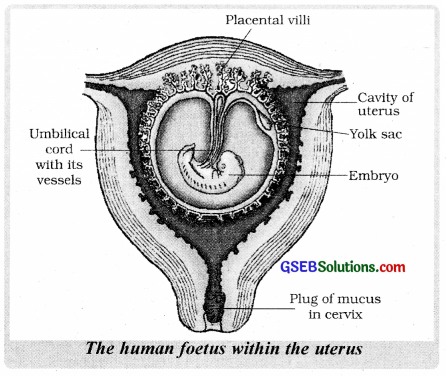
Question 36.
‘A fertilised egg is a blue print for future development’. Justify the statement.
Answer:
After fertilisation the repeated cell division takes place in the ovum and it forms zygote. The cells formed by cleavage are known as blastomeres. By repeated cleavage the zygote transforms into a solid mass of cells which resemble the mulberry fruit known as morula. The morula then forms blastula and then to gastrula. Upto this stage the cells are undifferentiated. After this stage the cells begin to differentiate and form different organs. So it is said that a fertilized egg is a blue print for future development.
![]()
Question 37.
Amnion is an effective shock absorber. Comment on it.
Answer:
The amnion provides a fluid medium to the developing embryo. This fluid prevents the desiccation of the embryo and thus acts as a shock absorber.
Question 38.
First trimester of pregnancy is critical. Give reason.
Answer:
In the first three months the development of the various organs takes place. After the third month development involves only growth and structural modification. So it is said that the first 3 months of pregnancy is critical and utmost care be taken.
Question 39.
Find the odd one out in each group and justify.
a. Vasa efferentia, epididymis, prostate gland, seminal vesicle, fallopian
b. Ovary, penis, vagina, uterus, oviduct
c. Proliferative phase, menstrual phase, multiplication phase, ovulatory phase, secretory phase.
d. Budding, gametogenesis, fertilization, cleavage, gastrulation
e. Acrosome, zona pellucida, distal centriole, middle piece, axial centriole
f. Amnion, foetus, chorion, allantois, yolk sac
Answer:
a. fallopian tube
b. penis
c. multiplication phase
d. budding
e. zona pellucida
f. foetus
![]()
Question 40.
Observe the diagram.
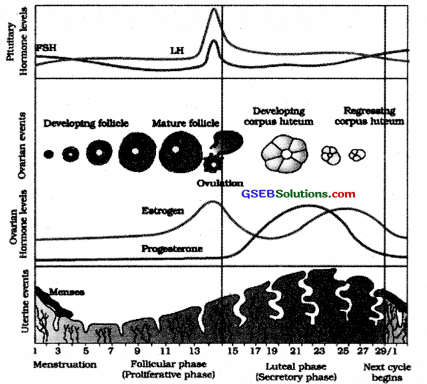
a. Where is this event taking place?
b. Write a note in the sequence from first day to twenty eight day, mentioning the four phases.
c. Give the names of the hormones involved in this event.
Answer:
a. Ovary and Uterus
b Menstrual cycle – proliferative phase, ovulatory phase, secretory phase and menstrual phase.
The rhythmic series of changes in the sex organs that occur about every 28 days throughout the reproductive life (i.e., from puberty to menopause) of a human female is called menstrual cycle. Menstrual cycle is absent during pregnancy and may be suppressed during lactation.
In a normal woman ovulation takes place on the 14th day after menstruation. If the ovum is not fertilized, the endometrium breaks and bleeding occurs. This monthly flow is known as menstruation or menses. During this time a series of changes occur in the reproductive organs and sexual behaviour of the female. Menstrual cycle is a combination of ovarian cycle
(series of events that results in ovulation and the development of corpus luteum constitutes the ovarian cycle) and uterine cycle (the cyclic events in which the uterine wall thickens, each time before ovulation and breaks down if fertilization does not occur. This constitutes the uterine cycle).
c. FSH, Estrogens, LH and Progesterone.
Question 41.
Change in nucleus, acrosome formation, changes in mitochondria, cen- trioles, cytoplasm. These events take place in a reproductive system.
a. In which reproductive system do these events take place?
b. Why do these changes take place?
Answer:
a. Male reproductive system
b. To transform the spermatid into a functional sperm.
Question 42.
The relaxin secreted by placenta relaxes the pubic ligaments during parturition.
i. Mention the other hormones secreted by placenta.
ii. Suppose relaxin is not secreted, mention the other method for the delivery of the child.
Answer:
i. HCG, chorionic thyrotropin, chorionic corticotropin, chorionic somatomammotropin, estrogen and progesterone.
ii. Caesarean operation.
![]()
Question 43.
Observe the flowchart showing the hormonal control of Menstrual cycle

a. Observe and name the hormones A, B, C and D
b. Copy the flow chart and represent the feed back mechanism in that.
Answer:
a. A – FSH, B – LH
C -Estrogen, D – Progesterone
b.
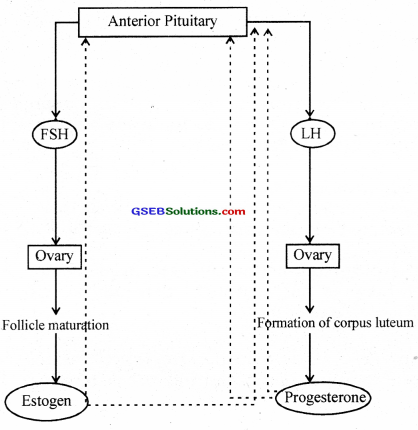
Question 44.
The diagram of human blastocyst is given below.

a. Identify A and B
b. Mention the fate of ‘B’
c. Copy and fill the given flow chart showing the fate of A

Answer:
a. A – Inner cell mass B – Trophoblast
b. B – It is converted into placenta

![]()
Question 45.
A concept map showing the filtration between glomerulus and Bowman’s capsule is given below.
Draw a concept map to show the filtration between uterine wall and placenta.

Answer:
Concept map shows the filtration process
It is two way filtration process
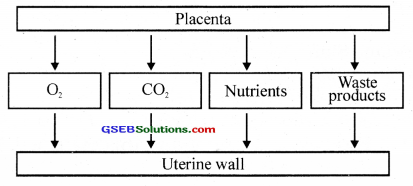
Question 46.
a. When and where does spermatogenesis in a human male begin to take place?
b. With the help of schematic labelled diagrams, trace the development of mature spermatozoa in a human male?
c. Describe the structure of a human sperm.
Answer:
a. In testis, the immature male germ cells (spermatogonia) produce sperms by spermatogenesis that begins at puberty.
k’ At Puberty
b.
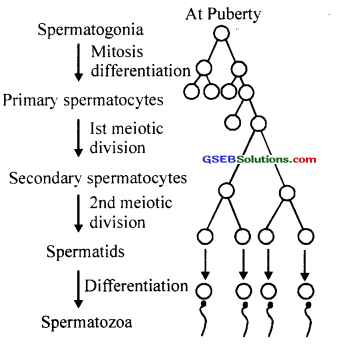
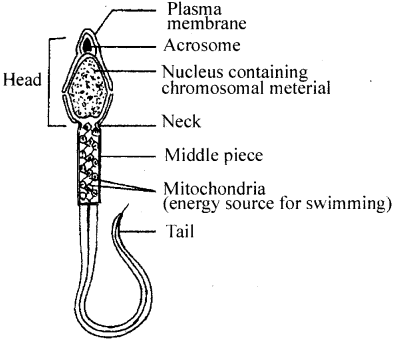
The structure of a sperm is divided into a head, neck, a middle piece and a tail. A plasma membrane envelops the whole body of sperm. The anterior portion of which is covered by a cup like structure called acrosome. Acrosome is filled with enzymes that help fertilisation of the ovum. The middle piece, possesses numerous mito¬chondria which produce energy for the movement of tail that facilitate sperm mo¬tility essential for fertilisation.
Question 47.
The events of the menstrual cycle are represented below. Answer the questions following the diagram.
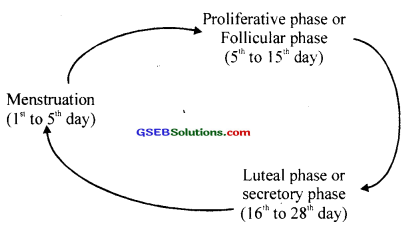
i. State the levels of FSH, LH and progesterone simply by mentioning high or low, around 13* and 14th day and 21st to 23rd day.
ii. In which of the above mentioned phases does the egg travel to the fallopian tube?
iii. Why is there no menstruation upon fertilisation?
Answer:
i. On 13th and 14th day LH high and FSH low. But on 21st and 23rd day FSH high and LH low.
ii. In proliferative phase or follicular phase egg travels to the fallopian tube.
iii. No menstruation upon fertilisation because the menstrual cycle stops and there is no menstruation. In the absence of fertilisation, the corpus luteum degenerates and this condition is called menopause.
![]()
Question 48.
At what stage of life is oogenesis initiated in a human female? When does the oocyte complete oogenesis?
Answer:
After the puberty stage of life oogenesis is initiated in human female. When oocyte changes into Graafian follicle, the process of oogenesis is complete.
Question 49.
Given below is an incomplete flow chart showing influence of hormones on gametogenesis in males. Observe the flow chart carefully and fill in the blanks A, B, C and D

Answer:
A – Luteinising hormone B – Spermatogenesis C – Sertoli cells D – Spermiogenesis
Question 50.
a. In which part of the human female reproductive system do the following events take place?
I – Release of 1st polar body.
II – Release of 2nd polar body
III – Fertilisation
IV – Implantation
Answer:
a. I – Stroma of the ovary
II – Ovary
III – Fallopian tube
IV – Uterus
b. From where do signals for parturition originate and what does maternal pituitary release for stimulating uterine concentrations for child birth?
![]()
Question 51.
Show diagrammatically the stages of embryonic development from zygote upto implantation in humans.
Answer:
The attachment of fertilized egg to the uterine wall of mother in placental animal is known as implantation.

a. Ovum
b. The haploid nucleus of the sperm and that of the ovum fuse together to form a diploid zygote.
c, d, e and f – Are the structures formed by cleavage. In the 16 celled stage, the structure is called morula. Finally the morula develops a cavity. In this stage, the structure is called blastocyst. It has an outer layer called trophoblast and inner group of cells called inner cell mass. The blastocyst becomes embedded in the endometrium of the uterus. This is called implantation and it leads to pregnancy.